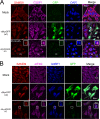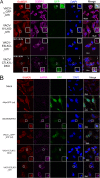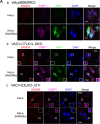SAMD9 is an innate antiviral host factor with stress response properties that can be antagonized by poxviruses
- PMID: 25428864
- PMCID: PMC4300762
- DOI: 10.1128/JVI.02262-14
SAMD9 is an innate antiviral host factor with stress response properties that can be antagonized by poxviruses
Abstract
We show that SAMD9 is an innate host antiviral stress response element that participates in the formation of antiviral granules. Poxviruses, myxoma virus and vaccinia virus specifically, utilize a virus-encoded host range factor(s), such as a member of the C7L superfamily, to antagonize SAMD9 to prevent granule formation in a eukaryotic initiation factor 2α (eIF2α)-independent manner. When SAMD9 is stimulated due to failure of the viral antagonism during infection, the resulting antiviral granules exhibit properties different from those of the canonical stress granules.
Copyright © 2015, American Society for Microbiology. All Rights Reserved.
Figures






Similar articles
-
Myxoma virus lacking the host range determinant M062 stimulates cGAS-dependent type 1 interferon response and unique transcriptomic changes in human monocytes/macrophages.PLoS Pathog. 2022 Sep 14;18(9):e1010316. doi: 10.1371/journal.ppat.1010316. eCollection 2022 Sep. PLoS Pathog. 2022. PMID: 36103568 Free PMC article.
-
Identification of Restriction Factors by Human Genome-Wide RNA Interference Screening of Viral Host Range Mutants Exemplified by Discovery of SAMD9 and WDR6 as Inhibitors of the Vaccinia Virus K1L-C7L- Mutant.mBio. 2015 Aug 4;6(4):e01122. doi: 10.1128/mBio.01122-15. mBio. 2015. PMID: 26242627 Free PMC article.
-
Stress Beyond Translation: Poxviruses and More.Viruses. 2016 Jun 14;8(6):169. doi: 10.3390/v8060169. Viruses. 2016. PMID: 27314378 Free PMC article. Review.
-
Non-replicating Vaccinia Virus TianTan Strain (NTV) Translation Arrest of Viral Late Protein Synthesis Associated With Anti-viral Host Factor SAMD9.Front Cell Infect Microbiol. 2020 Mar 20;10:116. doi: 10.3389/fcimb.2020.00116. eCollection 2020. Front Cell Infect Microbiol. 2020. PMID: 32266167 Free PMC article.
-
Innate immune recognition of poxviral vaccine vectors.Expert Rev Vaccines. 2011 Oct;10(10):1435-49. doi: 10.1586/erv.11.121. Expert Rev Vaccines. 2011. PMID: 21988308 Review.
Cited by
-
Novel biomarkers of resistance of pancreatic cancer cells to oncolytic vesicular stomatitis virus.Oncotarget. 2016 Sep 20;7(38):61601-61618. doi: 10.18632/oncotarget.11202. Oncotarget. 2016. PMID: 27533247 Free PMC article.
-
Rescue of a Vaccinia Virus Mutant Lacking IFN Resistance Genes K1L and C7L by the Parapoxvirus Orf Virus.Front Microbiol. 2020 Jul 28;11:1797. doi: 10.3389/fmicb.2020.01797. eCollection 2020. Front Microbiol. 2020. PMID: 32903701 Free PMC article.
-
High-throughput screening to enhance oncolytic virus immunotherapy.Oncolytic Virother. 2016 Apr 5;5:15-25. doi: 10.2147/OV.S66217. eCollection 2016. Oncolytic Virother. 2016. PMID: 27579293 Free PMC article. Review.
-
SAMD9L autoinflammatory or ataxia pancytopenia disease mutations activate cell-autonomous translational repression.Proc Natl Acad Sci U S A. 2021 Aug 24;118(34):e2110190118. doi: 10.1073/pnas.2110190118. Proc Natl Acad Sci U S A. 2021. PMID: 34417303 Free PMC article.
-
Emerging phenotypes linked to variants in SAMD9 and MIRAGE syndrome.Front Endocrinol (Lausanne). 2022 Aug 18;13:953707. doi: 10.3389/fendo.2022.953707. eCollection 2022. Front Endocrinol (Lausanne). 2022. PMID: 36060959 Free PMC article.
References
Publication types
MeSH terms
Substances
Grants and funding
LinkOut - more resources
Full Text Sources
Other Literature Sources
Molecular Biology Databases

